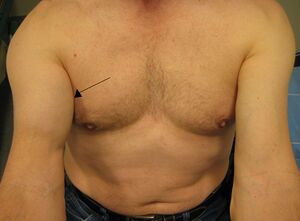Ludington’s Test: Difference between revisions
No edit summary |
No edit summary |
||
| (25 intermediate revisions by 3 users not shown) | |||
| Line 1: | Line 1: | ||
<div class="editorbox"> '''Original Editor '''- [[User:Kirega Bamurange Liliane|Kirenga Bamurange Liliane]] '''Top Contributors''' - {{Special:Contributors/{{FULLPAGENAME}}}}</div> | <div class="editorbox"> '''Original Editor '''- [[User:Kirega Bamurange Liliane|Kirenga Bamurange Liliane]] '''Top Contributors''' - {{Special:Contributors/{{FULLPAGENAME}}}}</div> | ||
== | == Introduction == | ||
[[File:Biceps tendon tear.jpeg|right|frameless]] | |||
Ludington's Test is a test that assesses for a [[Rupture Long Head Biceps|biceps tendon rupture]] or a [[Tendon Pathophysiology|tendon pathology]]. Ludington’s test is a recommended position in which to observe differences in the contour and shape of the [[Biceps Brachii|biceps]] <ref name=":0">Musculoskeletal key [https://musculoskeletalkey.com/biceps-tendon-rupture/ Biceps tendon rupture] Available:https://musculoskeletalkey.com/biceps-tendon-rupture/ (accessed 11.1.2022)</ref>. | |||
* Diagnosis of complete ruptures is relatively easy; patients often come in aware of the biceps muscle retraction. | |||
* Partial ruptures exist along a spectrum and can be more difficult to diagnose.<ref name=":0" /> | |||
Image 1: Popeye sign R upper limb, evident in biceps tendon ruptures | |||
== Technique == | == Technique == | ||
'''Starting position''' | '''Starting position''' <ref name=":1">Magee. Orthopedic Physical Assessment. 4<sup>th</sup> Ed. 2002. </ref><ref name=":2">Ludington's Test. Available from: <nowiki>https://www.thestudentphysicaltherapist.com/ludingtons-test.html</nowiki> (Accessed, 26 February 2021) | ||
</ref> | |||
The test can be performed with the patient | The test can be performed with the patient sitting with their back straight, on a chair or stool, their back to the examiner. | ||
'''Procedure''' | '''Procedure''' <ref name=":2" /> | ||
* The patient is instructed to clasp both hands on the top of their head, allowing the interlocking fingers to support the weight of the upper limbs. | * The patient is instructed to clasp both hands on the top of their head, allowing the interlocking fingers to support the weight of the upper limbs. | ||
* The examiner stands facing the patient's back in order to palpate the long head of the biceps tendon. | * The examiner stands facing the patient's back in order to palpate the long head of the biceps tendon. | ||
* The | * The patient then alternately contracts and relaxes the biceps while the clinician palpates the tendon and muscle. | ||
* | * In a complete tear, contraction is not felt on the affected side<ref name=":0" />. | ||
== Interpretation of the results == | == Interpretation of the results == | ||
A '''positive test''' for a rupture of the long head of the biceps is indicated by the | A '''positive test''' for a rupture of the long head of the biceps is indicated by the presence of the tendon's contraction on the side not tested and the absence of the tendon's contraction on the side being tested. The inability to feel the tendon indicates a long head of biceps tendon rupture<ref>Hattam P, Smeatham A. Special Tests in Musculoskeletal Examination. Edinburgh: Churchill Livingstone, 2010</ref>. | ||
== | <div class="col-md-6"> {{#ev:youtube|23sTljGyOXA|250}}<ref>The Physio Channel. Ludington's Bicep & Shoulder Test Positive or Negative? Available from: http://www.youtube.com/watch?v=23sTljGyOXA [last accessed 5/3/2021]</ref></div> | ||
<div class="col-md-6"> {{#ev:youtube|LGlSDlFLUA0|250}}<ref>Ccedseminars. Ludington's Test. Available from: https://www.youtube.com/watch?v=LGlSDlFLUA0 [last accessed 5/3/2021]</ref></div>See also [[Rupture Long Head Biceps|Rupture Long head of Biceps]] | |||
== Related Tests == | == Related Tests == | ||
#[[Elbow Hook Test]] | |||
# [[Flexion Initiation Test]] | |||
#[[Biceps Squeeze Test]] | |||
== References == | == References == | ||
| Line 37: | Line 40: | ||
[[Category:Musculoskeletal/Orthopaedics]] | [[Category:Musculoskeletal/Orthopaedics]] | ||
[[Category:Interventions]] | [[Category:Interventions]] | ||
<references /> | |||
Latest revision as of 02:39, 11 January 2022
Introduction[edit | edit source]
Ludington's Test is a test that assesses for a biceps tendon rupture or a tendon pathology. Ludington’s test is a recommended position in which to observe differences in the contour and shape of the biceps [1].
- Diagnosis of complete ruptures is relatively easy; patients often come in aware of the biceps muscle retraction.
- Partial ruptures exist along a spectrum and can be more difficult to diagnose.[1]
Image 1: Popeye sign R upper limb, evident in biceps tendon ruptures
Technique[edit | edit source]
The test can be performed with the patient sitting with their back straight, on a chair or stool, their back to the examiner.
Procedure [3]
- The patient is instructed to clasp both hands on the top of their head, allowing the interlocking fingers to support the weight of the upper limbs.
- The examiner stands facing the patient's back in order to palpate the long head of the biceps tendon.
- The patient then alternately contracts and relaxes the biceps while the clinician palpates the tendon and muscle.
- In a complete tear, contraction is not felt on the affected side[1].
Interpretation of the results[edit | edit source]
A positive test for a rupture of the long head of the biceps is indicated by the presence of the tendon's contraction on the side not tested and the absence of the tendon's contraction on the side being tested. The inability to feel the tendon indicates a long head of biceps tendon rupture[4].
See also Rupture Long head of Biceps
Related Tests[edit | edit source]
References[edit | edit source]
- ↑ 1.0 1.1 1.2 Musculoskeletal key Biceps tendon rupture Available:https://musculoskeletalkey.com/biceps-tendon-rupture/ (accessed 11.1.2022)
- ↑ Magee. Orthopedic Physical Assessment. 4th Ed. 2002.
- ↑ 3.0 3.1 Ludington's Test. Available from: https://www.thestudentphysicaltherapist.com/ludingtons-test.html (Accessed, 26 February 2021)
- ↑ Hattam P, Smeatham A. Special Tests in Musculoskeletal Examination. Edinburgh: Churchill Livingstone, 2010
- ↑ The Physio Channel. Ludington's Bicep & Shoulder Test Positive or Negative? Available from: http://www.youtube.com/watch?v=23sTljGyOXA [last accessed 5/3/2021]
- ↑ Ccedseminars. Ludington's Test. Available from: https://www.youtube.com/watch?v=LGlSDlFLUA0 [last accessed 5/3/2021]







